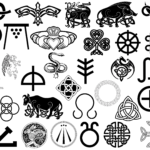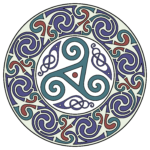Hey there! Let’s talk about the Celtic knot cross, a super cool symbol that’s been around for ages. We’ll dig into its history, what it means, and how it’s changed over time. Get ready to be dazzled by this ancient work of art that’s still blowing our minds today.
Celtic Knot Cross: An Enduring Symbol Unraveled
Picture this: a mesmerizing tangle of knots, dancing endlessly like an intricate puzzle. That’s the Celtic knot cross, a captivating symbol that has woven its way through history.
Unlike the Christian cross, the Celtic knot cross is more like an open-ended riddle. It’s a symbol of the interconnectedness of everything around us—you could say it’s nature’s own version of the World Wide Web!
Celtic knots have been around since the 7th century, each one with its own special story to tell. There’s the Trinity knot, which reminds us of the unity between heaven, earth, and ourselves. Then there’s the Borromean rings, a puzzle-like symbol that represents the eternal circle of life.
The Celtic cross, also known as the Irish cross, is a twist on the Celtic knot cross. It’s a cross with equal arms, all cuddled up inside a circle or a halo. You’ll often find these crosses in churches or graveyards, because they represent both faith and the endless loop of life and death.
Today, the Celtic knot cross isn’t just a relic of the past. It’s alive and well in jewelry, art, and even modern buildings. Whether it’s carved into an ancient stone or etched into a shiny new necklace, its timeless beauty and enchanting symbolism continue to make our hearts flutter.
Did you know that a Celtic cross is a distinctive type of cross with a circle in the center? You can discover more stunning Celtic symbols and their meanings by visiting our blog! Check This Out
How was the Celtic knot cross used in ancient times?
Celtic knot crosses, with their mind-boggling designs and deep meanings, have been around for ages in ancient Celtic cultures. But what did people actually use these mysterious things for back in the day?
Teaching Religion and Marking Boundaries
These knotty crosses weren’t just pretty decorations—they had a serious spiritual purpose. Their fancy patterns told stories about religion, helping people learn about their beliefs and guiding them on their spiritual paths. They also marked special areas, like sacred places, so people knew where to go for worship and other important stuff.
Safe Havens and Protection
Knotted crosses often stood like guardians, marking safe places where people could escape danger. Their intricate designs were thought to scare away evil spirits and create a holy space for praying and thinking.
Honoring Important Stuff and Remembering the Dead
These crosses also popped up on monuments and served as a way to remember people who had passed away. They marked significant events, celebrated lives, and linked the living world to the spiritual world.
Things to Remember:
- They were used to teach religion and mark special areas.
- They protected people from bad things and made sacred spaces.
- They honored important events and remembered people who had died.
Source:
Celtic Knot – The History and Symbolism Behind Celtic Knots]
What are the different types of Celtic knot crosses?
Picture this: a captivating symbol that has outlived centuries, standing tall as a testament to our world’s interconnectedness. That’s the essence of the Celtic knot cross, an open-ended marvel reminding us of the eternal web of life all around us.
The knots that intertwine in this enigmatic symbol carry profound meanings. Take the Trinity knot, also known as the Triquetra, that weaves together heaven, earth, and our very selves. Or the Borromean rings, a timeless tribute to the unending circle of life, where each ring relies on the others to exist.
One of the most iconic variations is the Celtic cross, or Irish cross, which proudly displays equal arms enclosed within a circle or halo. In the realm of Christianity, it embodies faith and the ever-turning cycle of life and death.
Fast forward to the present day, and the Celtic knot cross continues to enchant, gracing everything from exquisite jewelry and captivating art to architectural wonders. It’s a timeless treasure that represents the profound beauty and symbolism rooted in Celtic heritage.
So, there you have it—the captivating world of Celtic knot crosses, where each intertwining knot whispers stories of unity, strength, and the eternal tapestry of life.
What is the Significance of the Celtic Knot Cross in Modern Culture?
The Celtic knot cross, that cool symbol with all those twisted bits, has been around for ages, but it’s still super popular today. It’s kind of like an open-ended and intertwined version of the Christian cross, symbolizing how everything in life is connected.
Nowadays, you’ll see the Celtic knot cross everywhere – on jewelry, paintings, even buildings. It’s a way for people to show off their love for Celtic culture and its rich history. It’s like a stylish reminder of the wisdom and beliefs of those who came before us.
But what’s really special about the Celtic knot cross is its simplicity yet power. It’s just a few lines, but it says so much about the interconnectedness of the universe. It’s a symbol that speaks to people of all ages and walks of life, reminding us that we’re all part of something bigger than ourselves.
So, if you ever spot a Celtic knot cross, don’t just pass it by. Take a moment to appreciate its beauty and its message of unity. It’s a symbol that has stood the test of time and continues to inspire and connect us today.
FAQ
Q1: What is the Celtic knot cross?
A1: The Celtic knot cross is a stylized representation of an endless knot, symbolizing the intricate nature of humanity and the universe. It holds no religious or philosophical significance beyond this concept.
Q2: How does the Celtic knot cross differ from the Celtic cross with a Trinity knot?
A2: The Celtic cross with a Trinity knot is a symbol of Celtic heritage, faith, and the eternal cycle of life and death. It features a cross with a circle around it and an endless knot known as the Trinity knot.
Q3: What is the significance of Celtic knots in Celtic culture?
A3: Celtic knots have been an integral part of Celtic culture since the 7th century, representing spiritual and symbolic meanings. They are believed to represent eternity, interconnectedness, and the intricate balance of nature.
Q4: Where are Celtic knot crosses commonly found?
A4: Celtic knot crosses can be seen in various forms, such as jewelry, tattoos, and decorations on buildings. Historically, they were found in churches and graveyards, often serving as memorials or boundary markers.
Q5: What are the different types of Celtic knots?
A5: Celtic knots come in various forms, each with its unique meaning and significance. Some common types include the Trinity knot, Celtic Cross, Solomon’s knot, and the Dara knot. The Trinity knot represents the Holy Trinity, while the Celtic Cross symbolizes the unity of heaven and earth. The Solomon’s knot stands for wisdom and eternity, and the Dara knot signifies strength and endurance.
- China II Review: Delicious Food & Speedy Service - April 17, 2025
- Understand Virginia’s Flag: History & Debate - April 17, 2025
- Explore Long Island’s Map: Unique Regions & Insights - April 17, 2025
















